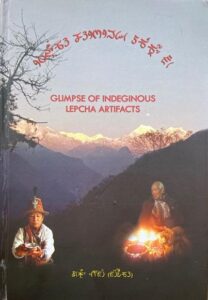
Aden Lepcha
Self published, 2021.
Reviewed by Charisma K. Lepcha, Sikkim University
Bongtenmu Mlublogpongsa Mikmer Kaat (2021) Glimpse of Indigenous Lepcha Artefacts by Aden Lepcha is a pioneering attempt to study the material culture of the Lepcha community. It explores and documents the tangible cultural heritage of Lepchas that have been of interest to many anthropologists and scholars ever since they started studying the community in the early twentieth century. Lepcha artefacts have been taken to museums abroad and displayed as part of their collection but these very objects are slowly disappearing from everyday use and being replaced by easily available market items.
This book presents a thorough exploration of everyday tangible items found in Lepcha homes, agricultural fields and their overall surroundings. From hunting implements to kitchen utensils, musical instruments and everyday wear, one can see how their natural environment has shaped Lepcha material culture. The author shows how bamboo is an important material in the creation of different baskets, utensils, and water vessels. It is also used to build bridges, construct houses and fishing tools. Lepcha ritual specialists are known to say a few lines about bamboo during their invocations as legends tell of the time when humans and bamboo species were created alongside and are considered siblings. Indeed, bamboos are found at plenty and the community has recognized its multi-functional purpose in their everyday lives.
This 122-page book however reads like a long article and organization of chapters could have been helpful. The author lists out the different artefacts and writes a thorough description of each object along with a photograph or two. While these artefacts are well documented, the author could have explicitly categorized the different items and even created a table to help readers find a specific object. It could have also been further analyzed and compared if all these objects are of indigenous origin or are a result of cultural contact.
One of the intentions of the author has been to impart traditional knowledge to the younger generation as the fear of losing indigenous knowledge found in everyday objects have been replaced by mass produced commercial items. The author’s individual effort by collecting all the objects described in the book is commendable and the photographs alongside are very useful in identifying objects that might have been overlooked. Material culture of Lepchas have been sparsely mentioned in both colonial and post-colonial study of the region and the community but this is the first time an entire book is dedicated to the same. While it feels like salvaging anthropology in the 21st century, the author has succeeded in initiating this effort to document and preserve the tangible heritage of the Lepcha community. This book may be of interest to scholars of anthropology, archaeology, cultural studies and indigenous studies of Northeast India.
